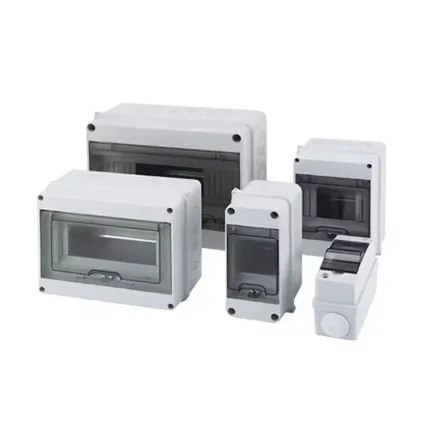
Preventing condensation in distribution boxes: application of heaters or moisture-proofing agents

The Silent Enemy Inside Your Electrical Enclosures
Imagine opening an electrical distribution box only to find water droplets clinging to your expensive components like dew on morning grass. That’s condensation—not just an annoying surprise, but a silent destroyer lurking in control cabinets worldwide. Whether it’s an outdoor enclosure weathering spring’s unpredictable swings or an indoor cabinet battling high humidity, condensation strikes when warm moisture-laden air meets surfaces cooler than the dew point.
Why should you care? Because those innocent-looking droplets are like ticking time bombs:
- Corrosion eating away at sensitive electronics
- Short circuits causing unexpected downtime
- Premature component failure leading to costly replacements
- Safety hazards from electrical arcing
Fun fact: A temperature difference as small as 15°F between internal components and cabinet surfaces can trigger condensation even at moderate humidity levels!
How Condensation Sneaks Into Your Systems
Based on industry observations, condensation typically invades through these seven pathways:
1. Temperature Rollercoasters
When transformers, VFDs, or PLCs heat up interiors while external surfaces stay cool, you’ve created perfect conditions for condensation—like a cold drink "sweating" on a summer day.
2. Humidity Havens
Coastal installations, rainy climates, or washdown areas provide relentless moisture sources. The higher the humidity, the smaller temperature drop needed to trigger condensation.
3. Thermal Shock
Moving enclosures from warm to cold environments creates instant condensation—similar to how your glasses fog up when entering an air-conditioned building.
4. Door Shuffle
Every maintenance check introduces warm humid air into the cabinet. It’s like inviting rain clouds inside each time you open the door.
5. Stale Air Syndrome
Without ventilation, trapped air grows more humid over time—essentially marinating components in moisture vapor.
Battle Strategies: Your Anti-Condensation Toolkit
Climate Control Warriors: Heaters
When temperatures dip or humidity spikes, purpose-built cabinet heaters step in as your first line of defense:
Fan Heaters: The Active Protectors
These workhorses circulate warmth throughout the cabinet like mini furnaces. Models like PFH-T units create enough heat displacement to prevent cold spots where condensation loves to form. They’re your go-to for larger enclosures in unpredictable climates.
Radiant Mini Heaters: Precision Strikers
For tight spaces where ventilation is limited, compact units like the PRH-M provide targeted warmth exactly where needed. Think of them as specialized snipers eliminating moisture threats in critical zones.
Smart Controllers: Your Moisture Detectives
Pairing heaters with hygrostats or thermostats transforms your system from reactive to intelligent defense. These controllers act like moisture-seeking radars, activating heaters only when humidity crosses your preset threshold—saving energy while maximizing protection.
Pro tip: Combining thermostats with filter fans? You’ll double your protection while extending equipment life and reducing energy consumption by up to 30%!
Moisture-Blocking Agents: The Invisible Shields
While heaters manage internal conditions, advanced materials prevent moisture infiltration at its source—incorporating moisture-proofing agents and specialized coatings forms an essential barrier strategy.
Polymer-Based Sealants
Modern silicone and urethane sealants expand and contract with temperature changes while maintaining waterproof barriers around conduit entry points. These flexible guardians fill gaps that rigid materials can’t.
Nano-Coatings
For sensitive components, hydrophobic nanocoatings create water-repellent surfaces so effective that droplets literally bounce off. Application methods range from simple sprays to specialized vapor deposition techniques.
Material Matters
Choosing enclosure materials with inherent moisture resistance is fundamental. Compared to thermally conductive aluminum that cools rapidly, polycarbonate or specially formulated polymers provide better insulation against condensation triggers.
Integrated Defense Systems
The most reliable protection combines technologies in a layered approach:
Layer 1: Ventilation
Filterfans with rain hoods provide constant air exchange while blocking external moisture. They serve as the foundation in non-hazardous environments.
Layer 2: Climate Control
Supplement ventilation with heaters regulated by hygrostats for humidity spikes and thermostats for temperature drops.
Layer 3: Physical Barriers
Apply moisture-proofing sealants to all entry points and specify waterproof flooring materials (like SPC flooring beneath installations) in high-moisture areas.
Layer 4: Smart Monitoring
Implement wireless humidity sensors with remote alerts so you’re notified of potential issues before they escalate.
The Maintenance Factor: Don’t Set and Forget
Even the best systems need check-ups:
Monthly
- Inspect seals and gaskets for wear
- Check drain vents aren’t clogged
- Verify heater operation with temperature gun
Quarterly
- Test hygrostat calibration
- replace air filters
- Check for new corrosion spots
Annually
- Reapply sealants at conduit points
- Check moisture-proofing integrity
- update monitoring firmware
Final Thoughts: Winning the Moisture War
Condensation in electrical enclosures isn’t inevitable—it’s manageable. By understanding how moisture behaves and implementing strategic combinations of heaters, moisture-proofing agents, ventilation, and proper maintenance, you can create environments where sensitive electronics thrive for decades rather than fail prematurely.
Remember: The most effective protection combines heating technology with physical moisture barriers, creating defense-in-depth that adapts to changing conditions. Whether you’re protecting a single control cabinet or an entire facility’s distribution network, a layered approach ensures your systems stay dry, reliable, and operational—no matter what the weather brings.
Proven systems can reduce condensation-related failures by up to 92% while extending equipment lifespan by 3-5 years!
Tags:
Recommend Products











